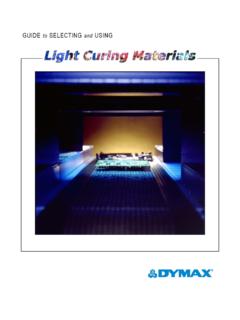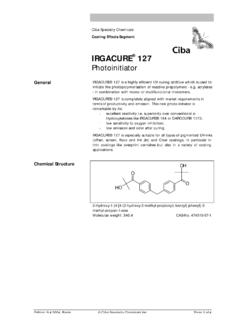Transcription of r Unique UV Urethane Adhesives, Coatings and …
1 Technical Paper Unique UV Urethane Adhesives, Coatings and Encapsulants Now Compete with Conventional Urethanes for Military and Space Applications F. By Joseph F. Vaccaro or years, adhesives made from requirements for space environments. UV technology have been used Recently, the military and space abundantly and successfully in industries have been under intense lower technology/price sensitive budgetary and competitive pressures commercial applications where rapid to increase manufacturing efficiencies UV cure meant higher output and and reduce processing times and costs. lower processing costs. However, for These industries are now seeking out the significantly more demanding faster curing, more production-friendly space and military applications, rapid material technologies such as snap- cure rates are not as important as cure thermosets and UV-cured performance requirements. A combina- adhesives, Coatings and encapsulants.
2 Tion of requirements such as extreme Industry leaders such as Boeing, Northrup Grumman, Raytheon, and Recently, the military and space industries have Lockheed Martin have approached specialty formulators to develop the been under intense budgetary and competitive next generation of rapid-cure adhesives, Coatings , and encapsulants pressures to increase manufacturing efficiencies with performance characteristics that and reduce processing times and costs. compete with the conventional Urethane systems. temperature cycling, outgassing, In this article, a basic comparison of hydrolytic stability, low modulus, low conventional versus acrylated Urethane glass transition temperature (Tg), high technology will be discussed. In elongation, complete cure in shaded addition, the application requirements, areas, and adhesion to difficult gold, recent developments, and test results ceramic, glass and plastic substrates, of next generation UV products will be have been traditionally met by compared to a long-time industry conventional thermoset Urethane standard Urethane adhesive/coating.
3 Adhesives. That is because up until recently, UV technology has had a Background and Technology tendency to yield adhesives, which are Comparison brittle, high in modulus, high in Tg, Conventional polyurethane and low in elongation. Importantly, elastomer technology has been field they also fail the NASA outgassing proven to be very successful and 48 RADTECH REPORT MARCH/APRIL 2003. Technical Paper versatile for military and space various reactions with water, polyols, ties of the formulated Urethane applications. In fact, many MIL specifi- and amines to produce very flexible to elastomers. This balancing act is cations have been written around this very rigid products, references such as possible for two-component urethanes technology. Adhesives, Coatings and Polyurethanes: Chemistry and by using a high-molecular weight encapsulants utilizing this chemistry Technology by Saunders and Frisch, prepolymer containing a partially provide excellent performance proper- Vols.
4 I and II, John Wiley and Sons, and adducted isocyanate and polyol ties such as toughness, flexibility, Reaction Polymers by Gum, Riese, moieties, which then can be crosslinked elongation, low Tg, low modulus, and Ulrich (editors), Hanser Publish- with selected low-molecular weight hydrolytic stability, etc. Because of ers, are good resources to use. Many polyols or amines. The hard Urethane these inherently good qualities, it made more sources are available as this segments or linkages would then form sense to use the Urethane backbone and chemistry is well documented. the hard segment domain during cure. adapt it to a UV-curing format. Flexible Urethane elastomers However, for UV-cured Urethane Polyurethanes were, indeed, found consist of mainly two segmented acrylates, this process of attaining the to be easily adaptable to UV cure. By structures long flexible polyol chains, two-phase structure is not easily reacting isocyanate prepolymers with usually called the soft segment, and possible with only the acrylate small, active OH-containing acrylated relatively short rigid polyurethane/ functionality.
5 Until recently, attaining monomers (for example, hydroxyethyl polyurea-based linkages called the the properties of conventional ure- acrylate or methacrylate) the active hard segment. The soft segment thanes has been difficult to achieve. N=C=O group of the prepolymer was usually has a Tg below -40 C and the The second issue to be addressed is replaced by a terminal acrylate hard segment has a Tg above +70 C. crosslink density. Again, this discussion functionality. Therefore, instead of the According to Woods2, the characteristic will only deal with flexible polyol-cured prepolymer reacting with polyols, properties of the resultant elastomer urethanes versus polyurethane amines or water to form conventional depend largely upon secondary or oligomers, which are completely urethanes/ureas, the acrylated end hydrogen bonding of polar groups in acrylated and cured with blends of groups were free to be polymerized the polymer chains.
6 Hydrogen mono and multi-functional monomers rapidly by free radicals generated from bonding between NH groups and the to achieve the desired handling and the appropriate photoinitiators. C=O (carbonyl) groups within the physical properties. The early developments of ure- polyurea/polyurethane hard segments Conventional soft, flexible, high- thane acrylates yielded adhesives/ is strong, causing the hard segments to elongation urethanes are mainly linear Coatings that were brittle, with high agglomerate into domains within in structure and possess a relatively Tg, high modulus and low elongation. structures having long flexible chains. low degree of branching, which can be Even today most Urethane acrylate In other words, a two-phase structure regulated by choosing the proper systems still do not approach the of hard and soft segments is formed. polyol/polyisocyanate precursors, flexibility and elongation that conven- The challenge is to balance the hard which themselves are branched to a tional flexible Urethane systems and soft segments within the dual degree.
7 Martin 3 states, as a measure possess. Although other factors may phase to develop the desired proper- of the crosslink density of a cured be involved, there appear to be, as noted by Martin1, two main reasons for this inherent molecular structure Diagram 1. and crosslink density. First of all, the molecular structure or morphology of polyurethane polymers will be discussed. However, the discussion will be basic and limited to polyol cured, flexible low modulus polymers/structures, which are more apropos to the subject matter of this paper. For an in depth study of polyurethane chemistry including the MARCH/APRIL 2003 RADTECH REPORT 49. Technical Paper Chart 1. Properties of a flexible aromatic Urethane acrylate oligomer diluted 25% with a monofunctional monomer, isobornyl acrylate (IBOA) compared to those properties of the same oligomer diluted 25% with the difunctional HDDA. Product Viscosity Shore Tg Tensile Elongation Young Cps@ Hardness ( C) strength % modulus 25 C @ 25 C psi CN 972*, diluted 25% 8000 80A -31 300 96 500.
8 With IBOA (monofunctional). Acrylated/UV-cured CN 972*, diluted 25% 3000 98A -28 500 38 2000. with HDDA (difunctional). Acrylated/UV-cured Uralane 5753-A/B ** 6000 55A -60 350 250 650. Conventional Standard (4). *products and data from Sartomer Company **Uralane 5753-A/B a registered trademark of Vantico conventional polyurethane network, in higher tensile strength, lower Urethane acrylate oligomer diluted the (average) equivalent weight per elongation, higher Tg, higher hardness 25% with a monofunctional monomer, branch point in the crosslinked and a more rigid product. isobornyl acrylate (IBOA) compared to polymer network, (designated as) Mc, Using a mathematical model, Martin those properties of the same oligomer will typically vary from 2,000 for a shows that for a 50/50 blend of difunc- diluted 25% with the difunctional flexible coating to about 25,000 for a tional oligomer of 1,000 molecular weight HDDA, discussed above, to show the (very) soft elastic material.
9 He goes and the difunctional monomer 1,6 effect of higher crosslink density. Data on to show that by contrast, for a hexanediol diacrylate, HDDA, (molecular for both systems are then compared to UV-cured formulation, the higher weight 226) the Mc, which he relates a long-time industry standard aromatic molecular weight oligomer contains at directly to crosslink density, would be Urethane , Uralane 5753-A/B, originally least two terminal acrylate groups, only 184. Even if the oligomer was of a developed more than 25 years ago by which upon curing/co-polymerizing molecular weight of 4,000, this model Furane Plastics. The IBOA system was with the lower molecular weight would yield an Mc of only 214, which selected because it closely matches the monomers become the branch points shows the dramatic effect the monomer's viscosity, tensile strength and modulus for the network. He shows (Diagram 1) functionality has on the resultant cured properties of the industry standard.
10 That the structure is usually not linear properties. All monofunctional mono- However, the hardness, Tg and and more highly branched. mers may be used to increase the Mc elongation differ substantially. It is the Due to viscosity/handling and flexibility, but the tensile property combination of all of these properties considerations, high molecular weight would decrease. Most formulators blend that make the Urethane standard oligomers, which impart flexibility mono and multifunctional monomers to important to military/space applications. and elongation, need to be diluted achieve compromises and approach 25-50% with low viscosity, low- conventional Urethane properties. The Military and Space Application molecular weight monomers having bottom line, though, is the acrylated Requirements mono-, di-, tri-, or higher functionality. systems are usually more crosslinked Military and space applications The higher the functionality of the than their conventional counterparts.









